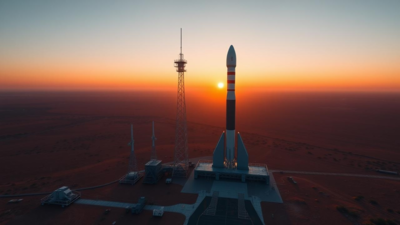
An Australian company says it aims to make the first orbital test launch of a locally-developed rocket on Thursday, carrying a jar of Vegemite as its payload.The three-stage Eris rocket is set to fly from a spaceport near Bowen on the east coast, said its developer, Gilmour Space Technologies.If successful, it would be the first Australian-made rocket to make an orbital launch from Australian soil.After securing approval from the Australian Space Agency, takeoff is expected within a multi-day window starting on Thursday, weather permitting, chief executive Adam Gilmour told AFP on Wednesday.But he’s not setting his hopes too high for now.If it actually orbits Earth “I would probably have a heart attack, actually, because I’ll be so surprised, but deliriously happy”, Gilmour said.“Look, we’re going to be happy if it gets off the pad — 10, 20, 30 seconds of flight time: fantastic. So orbit is just not in the realm of my belief right now, even though it’s theoretically possible.”The 23-metre vehicle — designed to launch small satellites into low-Earth orbit — is being prepared for takeoff from Abbot Point, about 1,000 kilometres (600 miles) up from the Queensland capital Brisbane.Weighing 30 tonnes fully fuelled, it relies on a “fairly unique” hybrid propulsion system, using a solid inert fuel and a liquid oxidiser, which provides the oxygen for it to burn, Gilmour said.The payload for the test flight is a jar of Vegemite — a popular Australian toast topping — but the rocket design is for a capacity of 100-200 kilogrammes (220-440 pounds), with further upgrades being developed.
‘We’ve done everything’:
The test launch comes after about a decade of research by the company, which is backed by private investors including venture capital group Blackbird and pension fund HESTA.“This is the first time an Australian company has done the design, build, manufacture, as well as the launch site. So we’ve done everything,” Gilmore said.The company, which has 230 employees, hopes to start commercial launches in late 2026 or early 2027, he said, and then to rapidly grow revenues.“This is a test launch, which is normal for rockets, and we’re going to see how we go and get as much data as we can — the more flight time we get the better,” Gilmour said.A second rocket was already being built for launch sometime around the end of the year.“We’re going after the small sat business,” he said.“There’s thousands and thousands of satellites that need to be launched into low orbit and there’s not enough rockets. The signs are so clear about that, so we’ve just got to move as fast as we can.”














